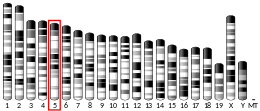GNPDA2
Glucosamine-6-phosphate deaminase 2 also known as GNPDA2 is an enzyme that in humans is encoded by the GNPDA2 gene.[5]
References
- GRCh38: Ensembl release 89: ENSG00000163281 - Ensembl, May 2017
- GRCm38: Ensembl release 89: ENSMUSG00000029209 - Ensembl, May 2017
- "Human PubMed Reference:". National Center for Biotechnology Information, U.S. National Library of Medicine.
- "Mouse PubMed Reference:". National Center for Biotechnology Information, U.S. National Library of Medicine.
- Arreola R, Valderrama B, Morante ML, Horjales E (September 2003). "Two mammalian glucosamine-6-phosphate deaminases: a structural and genetic study". FEBS Lett. 551 (1–3): 63–70. doi:10.1016/S0014-5793(03)00896-2. PMID 12965206.
- Zhao J, Bradfield JP, Li M, et al. (May 2009). "The role of obesity-associated loci identified in genome wide association studies in the determination of pediatric BMI". Obesity (Silver Spring). 17 (12): 2254–7. doi:10.1038/oby.2009.159. PMC 2860782. PMID 19478790.
- Renström F, Payne F, Nordström A, Brito EC, Rolandsson O, Hallmans G, Barroso I, Nordström P, Franks PW (April 2009). "Replication and extension of genome-wide association study results for obesity in 4923 adults from northern Sweden". Hum. Mol. Genet. 18 (8): 1489–96. doi:10.1093/hmg/ddp041. PMC 2664142. PMID 19164386.
- Willer CJ, Speliotes EK, Loos RJ, et al. (January 2009). "Six new loci associated with body mass index highlight a neuronal influence on body weight regulation". Nat. Genet. 41 (1): 25–34. doi:10.1038/ng.287. PMC 2695662. PMID 19079261.
Further reading
- Bauer F, Elbers CC, Adan RA, et al. (2009). "Obesity genes identified in genome-wide association studies are associated with adiposity measures and potentially with nutrient-specific food preference". Am. J. Clin. Nutr. 90 (4): 951–9. doi:10.3945/ajcn.2009.27781. PMID 19692490.
- Ota T, Suzuki Y, Nishikawa T, et al. (2004). "Complete sequencing and characterization of 21,243 full-length human cDNAs". Nat. Genet. 36 (1): 40–5. doi:10.1038/ng1285. PMID 14702039.
- Haupt A, Thamer C, Heni M, et al. (2009). "Novel Obesity Risk Loci Do Not Determine Distribution of Body Fat Depots: A Whole-body MRI/MRS study". Obesity (Silver Spring). 18 (6): 1212–7. doi:10.1038/oby.2009.413. PMID 19910938.
- Li S, Zhao JH, Luan J, et al. (2010). "Cumulative effects and predictive value of common obesity-susceptibility variants identified by genome-wide association studies". Am. J. Clin. Nutr. 91 (1): 184–90. doi:10.3945/ajcn.2009.28403. PMID 19812171.
- Strausberg RL, Feingold EA, Grouse LH, et al. (2002). "Generation and initial analysis of more than 15,000 full-length human and mouse cDNA sequences". Proc. Natl. Acad. Sci. U.S.A. 99 (26): 16899–903. doi:10.1073/pnas.242603899. PMC 139241. PMID 12477932.
- Brandys MK, van Elburg AA, Loos RJ, et al. (2010). "Are recently identified genetic variants regulating BMI in the general population associated with anorexia nervosa?". Am. J. Med. Genet. B Neuropsychiatr. Genet. 153B (2): 695–9. doi:10.1002/ajmg.b.31026. PMID 19746409.
- Renström F, Payne F, Nordström A, et al. (2009). "Replication and extension of genome-wide association study results for obesity in 4923 adults from northern Sweden". Hum. Mol. Genet. 18 (8): 1489–96. doi:10.1093/hmg/ddp041. PMC 2664142. PMID 19164386.
- He M, Cornelis MC, Franks PW, et al. (2010). "Obesity Genotype Score and Cardiovascular Risk in Women with Type 2 Diabetes". Arterioscler. Thromb. Vasc. Biol. 30 (2): 327–32. doi:10.1161/ATVBAHA.109.196196. PMC 3061473. PMID 19910641.
- Barbe L, Lundberg E, Oksvold P, et al. (2008). "Toward a confocal subcellular atlas of the human proteome". Mol. Cell. Proteomics. 7 (3): 499–508. doi:10.1074/mcp.M700325-MCP200. PMID 18029348.
- Hotta K, Nakamura M, Nakamura T, et al. (2009). "Association between obesity and polymorphisms in SEC16B, TMEM18, GNPDA2, BDNF, FAIM2 and MC4R in a Japanese population". J. Hum. Genet. 54 (12): 727–31. doi:10.1038/jhg.2009.106. PMID 19851340.
This article is issued from Wikipedia. The text is licensed under Creative Commons - Attribution - Sharealike. Additional terms may apply for the media files.



